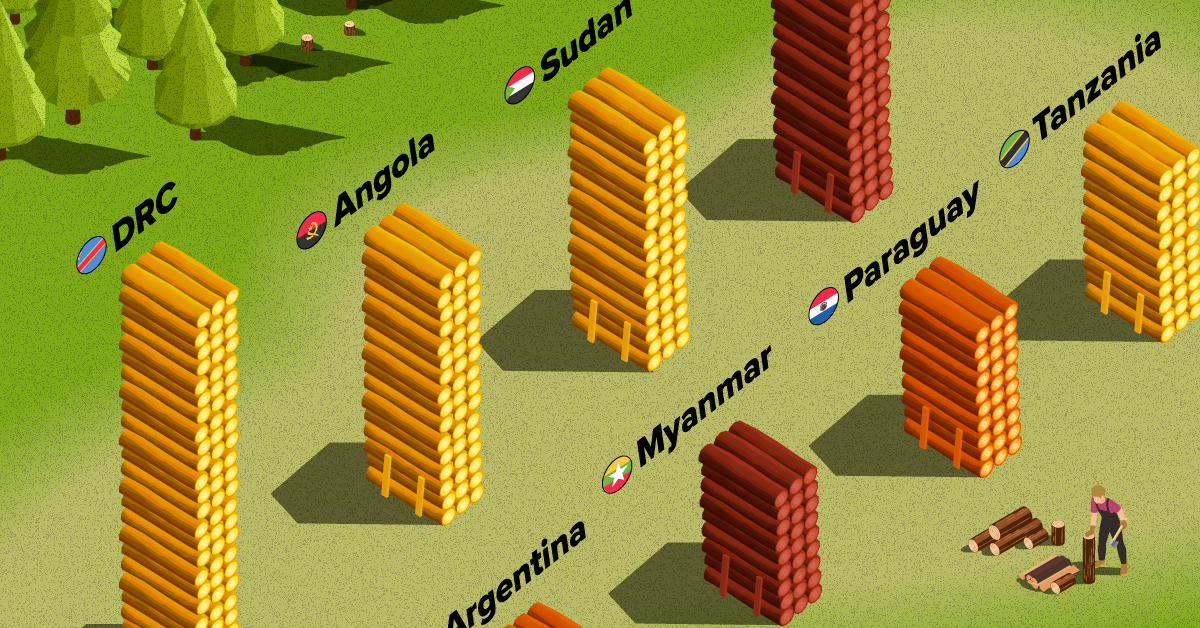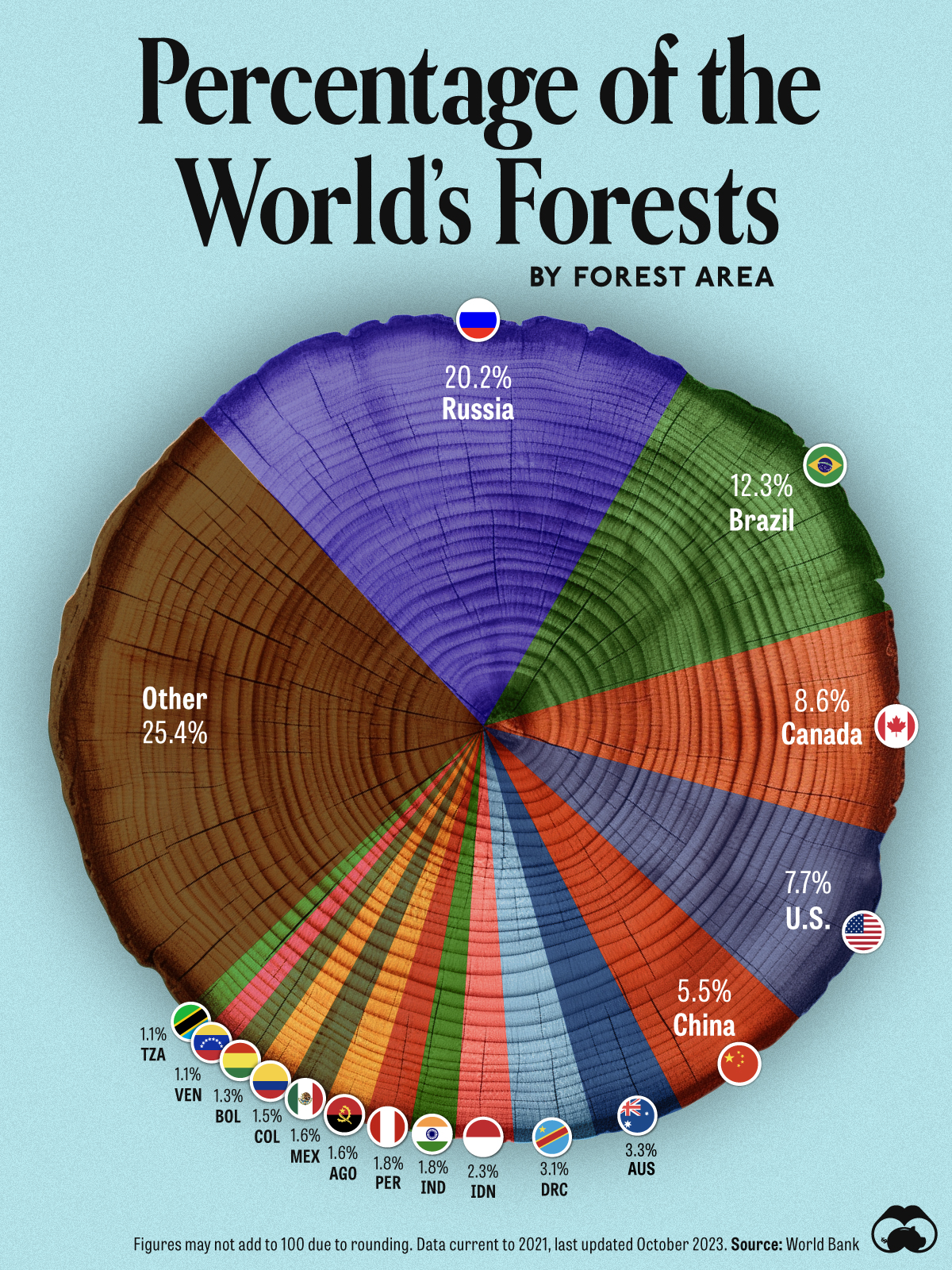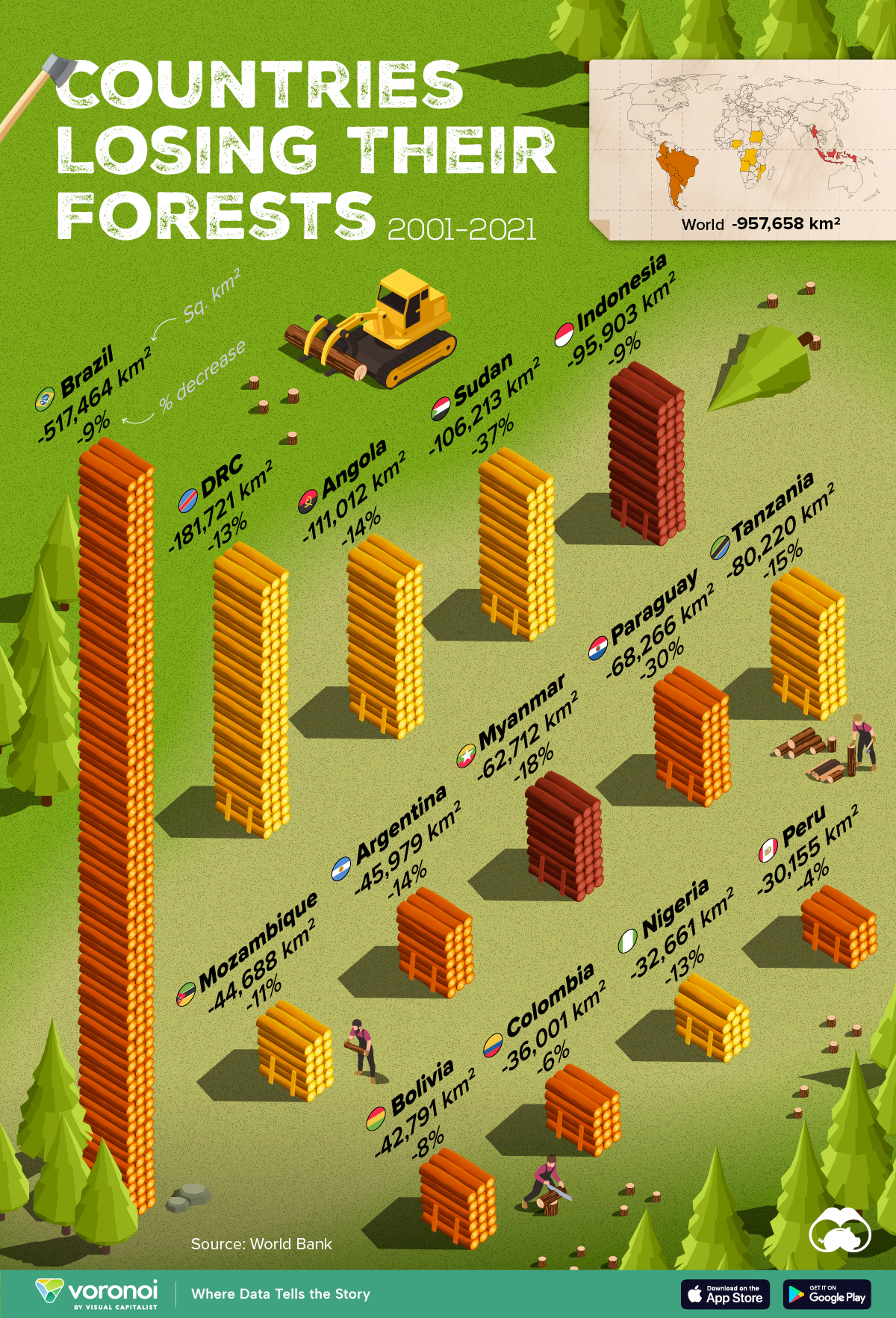Environment
Charted: Share of World Forests by Country
![]() See this visualization first on the Voronoi app.
See this visualization first on the Voronoi app.
Charted: Share of World Forests by Country
This was originally posted on our Voronoi app. Download the app for free on iOS or Android and discover incredible data-driven charts from a variety of trusted sources.
The world contains over three trillion trees.
The tropics and subtropics account for slightly less than half of all trees (1.3 trillion), the boreal regions for about one-fourth (0.74 trillion) and the temperate regions about one-fifth of the world’s forests (0.66 trillion).
What does this look like on a per country basis?
Using data from the World Bank, we visualize the share of the world’s total forest area per country.
Naturally larger countries tend to have more forest area, and thus, a greater percentage of the world’s forests, but it’s interesting to see how local environments also influence the metric.
Ranked: Countries with the Largest Share of World Forests
At the top of the list, Russia, has more than one-fifth of the world’s forests by itself. This is equal to 8 million km2 of forest, slightly less than half of the entire country.
| Rank | Country | Forest Area (Sq. km) | Forest Area (% of World's Forests) |
|---|---|---|---|
| 1 | 🇷🇺 Russia | 8,153,116 | 20.1% |
| 2 | 🇧🇷 Brazil | 4,953,914 | 12.3% |
| 3 | 🇨🇦 Canada | 3,468,911 | 8.6% |
| 4 | 🇺🇸 U.S. | 3,097,950 | 7.7% |
| 5 | 🇨🇳 China | 2,218,578 | 5.5% |
| 6 | 🇦🇺 Australia | 1,340,051 | 3.3% |
| 7 | 🇨🇩 DRC | 1,250,539 | 3.1% |
| 8 | 🇮🇩 Indonesia | 915,277 | 2.3% |
| 9 | 🇮🇳 India | 724,264 | 1.8% |
| 10 | 🇵🇪 Peru | 721,575 | 1.8% |
| 11 | 🇦🇴 Angola | 660,523 | 1.6% |
| 12 | 🇲🇽 Mexico | 655,643 | 1.6% |
| 13 | 🇨🇴 Colombia | 589,426 | 1.5% |
| 14 | 🇧🇴 Bolivia | 506,208 | 1.3% |
| 15 | 🇻🇪 Venezuela | 461,734 | 1.1% |
| 16 | 🇹🇿 Tanzania | 452,760 | 1.1% |
| 17 | 🇿🇲 Zambia | 446,258 | 1.1% |
| 18 | 🇲🇿 Mozambique | 364,976 | 0.9% |
| 19 | 🇵🇬 Papua New Guinea | 358,222 | 0.9% |
| 20 | 🇦🇷 Argentina | 284,637 | 0.7% |
The fifth-biggest (and sixth-most populated) country, Brazil, ranks second with slightly more than 12% of total forests, close to 5 million km2, which is more than 60% of the whole country. The biggest contributor to its forest cover is the Amazon, which has lost 237,000 km2 in the span of five years because of deforestation. The Amazon is also a significant part of Peru’s forest cover (ranked 10th on this list, with 1.8% share).
Canada and the U.S. each have about 8% of the world’s forests within their borders. Both countries have developed beloved national park systems aimed at protecting the natural biodiversity of the continent.
China rounds out the top five, with its 5.5% share. Unlike other nations whose forest cover has seen a steady decline, China managed to increase its forest area by 511,807 km2 in two and a half decades, an area that is bigger than the entirety of Thailand. The country also aims to have about 30% of the country covered by forests by 2050. Critics state that this massive reforestation drive might come at the cost of maintaining natural tree species, and instead promotes monocultures of non-native trees.
Meanwhile, Australia and the Democratic Republic of Congo (DRC) each share 3% of the world’s forests. The Congo Basin, the world’s second largest tropical rainforest, contributes heavily to the latter’s forest cover, and spreads out over five other countries: Cameroon, Central African Republic, Congo, Equatorial Guinea and Gabon.
Indonesia, India, and Peru round out the top 10 with a 2% share each.
Green
Ranked: Top Countries by Total Forest Loss Since 2001
The country with the most forest loss since 2001 lost as much forest cover as the next four countries combined.

Ranked: Top Countries By Total Forest Loss Since 2001
This was originally posted on our Voronoi app. Download the app for free on iOS or Android and discover incredible data-driven charts from a variety of trusted sources.
Forests are critical natural resources, often caught in the crosshairs of economic development. Thanks to expanding human settlement, agriculture, and industry, the world lost nearly 1 million square kilometers (km²) of forest cover since 2001.
But where has most of this deforestation occurred?
We rank the countries by the total decrease in their forest area between 2001 and 2021, measured in square kilometers along with their percentage decrease for context. All of this data was sourced from the World Bank.
A caveat to this data: countries are ranked by total forest loss, so countries with the largest forests feature predominantly on this list.
Which Country Has Lost the Most Forests (2001-2021)?
Brazil has lost more than half a million square kilometers of forest in the last two decades. Agricultural expansion for beef and soy production alongside mining and infrastructure growth are the primary drivers behind this large scale deforestation.
This has also caused periodic fires in the Amazon rainforest, drawing repeated alarm from around the world. In fact, Brazil has lost as much forest cover as the next four countries combined.
The table below lists the countries included in this graphic, as well as several others further down the ranking.
| Rank | Country | Region | 2001–21 Change (in km2) | % of Forest Loss |
|---|---|---|---|---|
| 1 | 🇧🇷 Brazil | South America | -517,464 | -9% |
| 2 | 🇨🇩 DRC | Africa | -181,721 | -13% |
| 3 | 🇦🇴 Angola | Africa | -111,012 | -14% |
| 4 | 🇸🇩 Sudan | Africa | -106,213 | -37% |
| 5 | 🇮🇩 Indonesia | Asia | -95,903 | -9% |
| 6 | 🇹🇿 Tanzania | Africa | -80,220 | -15% |
| 7 | 🇵🇾 Paraguay | South America | -68,266 | -30% |
| 8 | 🇲🇲 Myanmar | Asia | -62,712 | -18% |
| 9 | 🇦🇷 Argentina | South America | -45,979 | -14% |
| 10 | 🇲🇿 Mozambique | Africa | -44,688 | -11% |
| 11 | 🇧🇴 Bolivia | South America | -42,791 | -8% |
| 12 | 🇨🇴 Colombia | South America | -36,001 | -6% |
| 13 | 🇳🇬 Nigeria | Africa | -32,661 | -13% |
| 14 | 🇵🇪 Peru | South America | -30,155 | -4% |
| 15 | 🇰🇭 Cambodia | Asia | -28,491 | -26% |
| 16 | 🇻🇪 Venezuela | South America | -28,130 | -6% |
| 17 | 🇲🇽 Mexico | North America | -26,732 | -4% |
| 18 | 🇿🇲 Zambia | Africa | -23,924 | -5% |
| 19 | 🇧🇼 Botswana | Africa | -23,660 | -14% |
| 20 | 🇨🇮 Cote d'Ivoire | Africa | -22,577 | -45% |
What is quickly apparent is how most of the countries on this list are from Africa and South America. A study found a correlation where developing economies tend to have higher deforestation rates than advanced economies. Former colonies have also experienced more forest loss than those that were not colonized.
In Asia, Indonesia’s burgeoning palm oil industry is a key driver to deforestation, though efforts are now being made to reverse its impact. Meanwhile, Cambodia experienced rapid clear-cutting for its growing rubber plantations and timber industry.
Finally, Myanmar has long contended with illegal logging, but the country’s ongoing civil war is styming conversation efforts.
-

 Debt1 week ago
Debt1 week agoHow Debt-to-GDP Ratios Have Changed Since 2000
-

 Markets2 weeks ago
Markets2 weeks agoRanked: The World’s Top Flight Routes, by Revenue
-

 Countries2 weeks ago
Countries2 weeks agoPopulation Projections: The World’s 6 Largest Countries in 2075
-

 Markets2 weeks ago
Markets2 weeks agoThe Top 10 States by Real GDP Growth in 2023
-

 Demographics2 weeks ago
Demographics2 weeks agoThe Smallest Gender Wage Gaps in OECD Countries
-

 United States2 weeks ago
United States2 weeks agoWhere U.S. Inflation Hit the Hardest in March 2024
-

 Green2 weeks ago
Green2 weeks agoTop Countries By Forest Growth Since 2001
-

 United States2 weeks ago
United States2 weeks agoRanked: The Largest U.S. Corporations by Number of Employees















